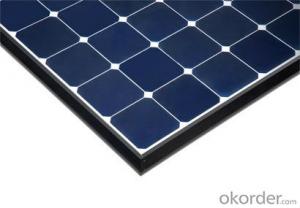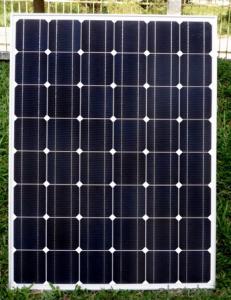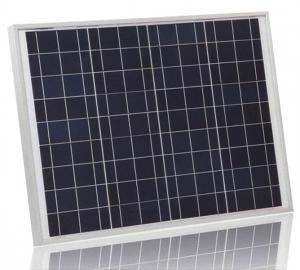Oncor Solar Panels - CNBM Poly Solar Panel 290W A Grade with Factory Price
- Loading Port:
- Shanghai
- Payment Terms:
- TT OR LC
- Min Order Qty:
- 100 watt
- Supply Capability:
- 100000 watt/month
OKorder Service Pledge
OKorder Financial Service
You Might Also Like
Specification
CNBM Poly Solar Panel 290W A Grade with Factory Price
Production description
solar panels that can always be pointed at the Sun even as the rest of the body of the spacecraft moves around, much as a tank turret can be aimed independently of where the tank is going.
A photovoltaic (in short PV) module is a packaged, connected assembly of typically 6×10 solar cells. Solar Photovoltaic panels constitute the solar array of a photovoltaic system that generates and supplies solar electricityin commercial and residential applications. Each module is rated by its DC output power under standard test conditions, and typically ranges from 100 to 365 watts. The efficiency of a module determines the area of a module given the same rated output – an 8% efficient 230 watt module will have twice the area of a 16% efficient 230 watt module.
Depending on construction, photovoltaic modules can produce electricity from a range of frequencies of light, but usually cannot cover the entire solar range (specifically, ultraviolet, infrared and low or diffused light). Hence, much of the incident sunlight energy is wasted by solar modules, and they can give far higher efficiencies if illuminated with monochromatic light. Therefore, another design concept is to split the light into different wavelength ranges and direct the beams onto different cells tuned to those ranges.[citation needed] This has been projected to be capable of raising efficiency by 50%. Scientists from Spectrolab, a subsidiary of Boeing, have reported development of multijunction solar cells with an efficiency of more than 40%, a new world record for solar photovoltaic cells.

Application
Aerospace
Residential
Commercial
Large solar power plant
Distributed plant
Product Feature
1.A grade high efficiency solar cells.
2.TUV/UL/CE/CEC etc
3.Fast shippment
4.25 years warranty
5.OEM
Package
24pcs into one carton, 312pcs into a 20 foot container, 728pcs into a 40 foot container.
- Q: What is the payback period for solar panels?
- The payback period for solar panels refers to the time it takes for the savings from reduced energy bills to equal the initial investment in installing the solar panels. The payback period can vary depending on factors such as the cost of the panels, the amount of sunlight in the location, and the local electricity rates. On average, the payback period for solar panels is around 5 to 10 years, but it can be shorter or longer depending on these factors.
- Q: I want to buy a solar panel kit but I'm unsure of how it works. Basically I want to run my entainment set, Xbox, cable box, 46 led tv, and some desktop speakers. I went online and found a kit for like 250 or something like that at homedepot and was wondering if that kit is worth the money or go bigger or something.
- Well, you'll want to find the wattage your devices use. Then you'll want to be able to supply that with your solar cells. Plus a fair margin for emergencies. Most of them should have their expected wattage printed on them, but you could also get a meter to measure it. Beyond that, you will want an inverter, and some batteries.
- Q: Is it possible to store energy from solar panels for night?
- Why pay thousands of dollars for solar energy ($27,000 average cost) when you can build your own solar panel system for just a fraction of the retail cost. You can build a single solar panel or you can build an entire array of panels to power your whole house. Some people are saving 50% on their power bill, some people are reducing their bill to nothing. But what’s most impressive is that just by following these instructions some are even making the power company pay them!
- Q: What is the impact of dust and dirt on solar panels' efficiency?
- Dust and dirt can significantly impact the efficiency of solar panels. When a layer of dust accumulates on the surface of the panels, it reduces the amount of sunlight reaching the solar cells, thereby reducing their ability to convert sunlight into electricity. This decrease in efficiency can range from a few percentage points to even as much as 20% in extreme cases. Therefore, regular cleaning and maintenance of solar panels are essential to maintain their optimal performance and maximize energy production.
- Q: Do solar panels require permits for installation?
- Yes, solar panels generally require permits for installation. The specific requirements and regulations for obtaining permits may vary depending on the location and local building codes. However, in most cases, permits are necessary to ensure compliance with safety standards, electrical codes, and zoning regulations. It is advisable to consult with local authorities or a professional solar installer to determine the exact permitting process in a specific area.
- Q: Can solar panels power an entire home?
- Yes, solar panels can power an entire home. The number of solar panels required will depend on the energy needs of the home and the efficiency of the panels. With the right setup and sufficient sunlight, solar panels can generate enough electricity to cover the energy consumption of a household.
- Q: I am doing a project for school and i need to power a 9v DC motor using a solar panel. Does anyone know places i could get these for not to expensive, and how many volts/watts i would need?
- I too want to buy the panels to light up my house.
- Q: Can solar panels be used in areas with high levels of shade or obstruction?
- Solar panels are not very efficient in areas with high levels of shade or obstruction as they rely on direct sunlight to generate electricity. However, there are certain technologies and panel designs available that can still produce energy in shaded areas to some extent, although their overall efficiency may be reduced.
- Q: how to market solar energy products?
- It depends upon your product. If it is a solar panel, I want to know if it is a photovoltaic panel or a thermal panel. If you don't know enough to know the difference for your question it might be somewhat difficult to suggest others should buy them. Products have to be marketed to a need either already felt or not so apparent. Photovoltaic panels supply an electric need and will offset electrical usage or may supply the grid if there is excess power. A discussion of payback periods including property values will be needed in any event. Thermal panels supply heat and hot water. They are more efficient than photovoltaic panels and will give faster payback times. (are cheaper) If you are a bit more specific more information may be possible.
- Q: Are there any risks associated with solar panel installation?
- Yes, there are a few risks associated with solar panel installation. These include the potential for damage to the roof during installation, the risk of electrical shock if not installed properly, and the possibility of fire hazards if the electrical system is not correctly designed or maintained. However, by hiring professional installers and following safety guidelines, these risks can be minimized.
Send your message to us
Oncor Solar Panels - CNBM Poly Solar Panel 290W A Grade with Factory Price
- Loading Port:
- Shanghai
- Payment Terms:
- TT OR LC
- Min Order Qty:
- 100 watt
- Supply Capability:
- 100000 watt/month
OKorder Service Pledge
OKorder Financial Service
Similar products
Hot products
Hot Searches
Related keywords


























